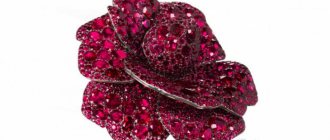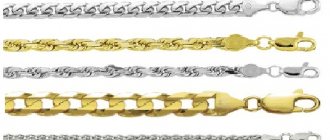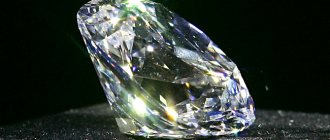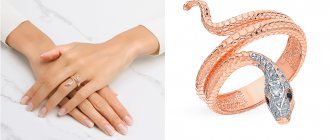Exquisite jewelry made from precious stones and precious metals is pleasing to the eye and is a welcome gift. Jeweler is a profession with a rich history and has its own professional holiday. When is Jeweler's Day 2021 celebrated in Russia and the world?
Jewelry making is the art of processing precious materials and making jewelry, a type of decorative and applied art. Its history goes back a long way. People have long decorated themselves by making pendants, beads and bracelets from shells, fangs, and stones. Then metal became the material for jewelry: meteorite iron, copper, bronze, gold, silver, platinum. Each era created jewelry in its own way, which was reflected in the choice of material, methods of processing, technique and language of artistic forms.
When is Jeweler's Day celebrated in Russia and the world?
The date of this holiday is fixed - every year around the world International Jeweler's Day is celebrated on January 31. The date was not chosen by chance: it is in January that jewelers register their hallmarks.
Able to engrave
Article on the topic The richest profession. January 31 is Jeweler's Day. The word “jeweler” was borrowed from the Turkic language and is translated as “one who knows how to engrave.” The profession itself is considered one of the most ancient. The first jewelry was found by archaeologists during the excavation of the pyramid of the Egyptian pharaoh Djoser (3200–2800 BC). Of course, in pre-Christian times, the decoration of stones and metals was much rougher than now, but even then jewelry was given a sacred meaning.
Historical information
Jewelry making traces its history back to ancient times. The desire to decorate oneself and one's home was inherent in primitive people. “Revice” materials were used. Primitive jewelry was made from bird feathers, hewn stones, bones, and later from bronze.
The ancient Egyptians excelled in jewelry making. Examples of their bulky decorations were first found by archaeologists in the Pyramid of Djoser (3rd century BC).
The first jewelry workshops were organized by the enterprising ancient Greeks.
They began to use pearls and precious stones in their products, grinding them to a smooth or faceted shape.
Jewelry craft was especially in demand in the eastern countries.
In the Middle Ages, the largest customer for jewelry products was the church. She needed special utensils, frames for books and images, folding altars, baptismal fonts for infants, and vessels of various shapes. All these items were made of gold, silver and inlaid with precious stones.
And in Rus', skilled craftsmen working with precious metals and stones have always been held in special esteem.
In 1725, by decree of Peter I, the first state-owned lapidary factory for the artistic processing of colored stone was opened in Peterhof. At the enterprise, according to the expression of that time, “diamonds were cut,” precious stones were cut and young craftsmen were trained.
Among modern jewelry products, there are many products made in a “serial” way (by casting or stamping).
However, making jewelry masterpieces by hand has not lost its relevance today. Wealthy people are willing to shell out huge amounts of money for unique works by recognized jewelry masters.
To become a jeweler you need good eyesight and patience.
The profession of a jeweler is considered extremely profitable and highly paid - precious jewelry and luxury items will always be in fashion, despite economic turmoil. However, this job is not for everyone. Firstly, in order to become a jeweler, imagination alone is not enough; knowledge and understanding of chemistry and mathematics are required. Secondly, performing complex work requires good vision.
Jeweler at work. Photo: RIA Novosti
Present
Book. A catalog of antique jewelry or a gift-bound book about jewelry making would be a good idea for a themed holiday gift.
Portrait. An exclusive portrait, made in a vintage or unusual modern style, will be an excellent gift for a creative person.
Sweet gift. A cake in the form of a precious decoration and with the emblem of a jewelry company will be an original gift that will come in handy for the holiday table.
The patrons of Orthodox jewelers are Cosmas and Domian, and those of Catholic jewelers are Dunstan.
In the Orthodox faith, the patrons of handicrafts, which include jewelers, are Cosmas and Domian. Their memorial days are celebrated on July 14 and November 14. The patron saint of Catholic jewelers is Dunstan. There is a legend that the devil came to the saint’s forge and asked him to shoe him. The blacksmith recognized the evil one and therefore shoed the devil too painfully that he had to beg for mercy. Dunstan freed the uninvited guest, but on the condition that he would never cross the threshold of the place where there was a horseshoe.
Interesting facts about the International Jeweler's Day holiday
The Republic of Sakha (Yakutia) established its own holiday in honor of jewelry workers; it is celebrated on October 23. The decree on its creation was signed by the President of the Republic. This happened 10 years ago.
The word jeweler comes from the German word juwel, which can be translated as precious stone.
Workers of this craft have patrons - Saints Cosmas and Damian.
Currently in the world, jewelry is made from the following precious stones: gold, silver, platinum, iridium, osmium, palladium and ruthenium.
To make jewelry from gold or silver, metals are not used in their pure form, and this is due to the fact that they are very soft and do not have sufficient strength for long service, and therefore they are mixed with other alloys.
Jeweler is a hereditary profession
Most often, the profession of a jeweler is “passed on by inheritance” - there are often cases when, over the course of decades, or even centuries, the skill of cutting stones has been passed on from generation to generation. For example, a jewelry dynasty from the Moroccan city of Tiznit, whose representatives have been creating their famous products for many centuries.
Exhibits of the Faberge Museum in St. Petersburg. Photo: www.globallookpress.com
How do jewelers work?
From open sources
A jeweler's specialty involves processing stones and metals, drawing sketches, modeling and bringing ideas to life.
There are several specializations in the jeweler profession:
- installers;
- fixers;
- filigree workers;
- engravers;
- chainmen;
- artists;
- cutters;
- shareholders;
- grinders;
- enamellers;
- designers.
Jewelers can work in different places: both in small private workshops and in huge jewelry factories. Jewelers can also often be found in pawnshops, shops and expert bureaus.
Jewelers work with jigsaws, files, soldering irons, drills, pliers, hammers, drills, tweezers and other tools.
The most famous and poorest jeweler
Perhaps the most famous jeweler is Carl Faberge - his name is familiar to people not interested in jewelry, and his works are highly valued by collectors. The St. Petersburg master created the first egg in 1885 for the wife of Tsar Alexander III , and the most expensive product of the Russian master Faberge was the egg, sold at auction for $18.5 million.
Despite this, the great master died in poverty - after the revolution of 1917, all of Faberge's property was arrested, and he himself had to leave the country.
Curious facts
- Pure gold or silver is not used to make jewelry. These metals are not very strong. Therefore, jewelers use alloys with a certain percentage of gold or silver content. The sample indicates the amount of gold or silver content in the jewelry.
- In the jewelry business, it is especially valued when children adopt the skills and experience of their parents and continue the family craft.
- Hot-tempered and emotionally unstable people who can spoil expensive material in the process of hard work are not allowed to study jewelry making. Future jewelers are required to undergo special psychological tests and consultation with a narcologist.
- The root of the word “jeweler” is common or similar in several languages: German – Juwelier, English – jeweler, Portuguese – joalheiro.
- In Baden-Baden there is a museum of the founder of the famous Russian dynasty of skilled jewelers, Carl Faberge. The museum exhibition includes the avant-garde still life “Proletarian Breakfast” (a scrap of newspaper, a cut glass, a cigarette butt, a herring ridge, a fried egg), created using expensive materials in the workshop of a great jeweler. The estimated cost of a “modest” breakfast is $1,100,000.
International Jeweler's Day - a holiday for goldsmiths
5 (100%) 1 vote
Share this article:
How are Jeweler's Day celebrated?
1. In many countries, on January 31, the professional holiday of jewelers, exhibitions of precious stones and the best jewelry are organized. The most famous jewelry makers show their jewelry works or present to the public ancient precious items that were created several centuries ago. Such events allow you to enjoy the beauty of unique jewelry created by human hands. The significance of exhibitions is very great, because they reveal how great the work of the jewelry craft is, how real professionals give “new life” to precious metals and stones.
2. On this day, workers of ancient art not only show the jewelry they created, but also organize meetings with their colleagues in order to congratulate and exchange experiences, techniques, ideas, plans and innovative solutions. 3. In our country, the holiday is considered young, so not everyone knows about its existence. But every jeweler rushes to congratulate his colleagues on his professional holiday. 4. In Yakutia, jewelers celebrate their professional holiday on October 23 of each year. At the regional level, the celebration is official, which is confirmed by the Decree of the President of the Republic of Yakutia. 5. In our country, jewelry festivals are held on this day, a tradition that was founded in 2002. 6. As a congratulation to the master jeweler, you should present a themed cake in the form of a piece of jewelry. It would also be a wonderful gift to give the jeweler a ticket to attend a festival or exhibition. It will be an unexpected surprise and very interesting. 7. On a professional day, you can meet with work colleagues and have a pleasant evening in a cozy restaurant or cafe. 8. In honor of a professional holiday, you can organize a competition between several colleagues, the essence of which will be the same task. It can be on speed of execution or manufacturing technique. The winner is determined by the clients of the jewelry house. When holding such an event, it is worth thinking in advance about the gift that will be presented to the leader of the competition. Jewelry craft is necessary for humanity at all times. Using their talent and creativity, jewelers give us a new world filled with aesthetic beauty. For this reason, we are obliged to congratulate all jewelry masters on their professional holiday.
What can a jeweler do?
1. Create a sketch of the decoration. At this stage, the master carries out modeling and must mentally imagine the finished product. 2. Prepare the product. Here the jeweler casts, mounts and carries out the necessary processing of the product. 3. The creative stage includes: applying engravings, patterns and drawings. 4. Working with stones: selection, installation and fastening. 5. Working with protective coating. Jewelry craftsmen work in every country in the world and in every big city. The significance of this craft has no boundaries. Each of us can thank the masters on their professional holiday, which falls on January 31 of each year. Historical background The origins of jewelry craft take us to the distant times of Ancient Greece. It was there that products from semiprecious stones, amber, emerald and diamonds began to be made for the first time.
According to historical sources, it is generally accepted that the origin of this industry was on the threshold of the 3rd millennium BC. In Rus', jewelry craftsmen became famous in the 9th – 12th centuries. For royalty, artisans created real works of art in the form of symbols of royal power: crowns, rings, sceptres, frames, wands and orbs. The best craftsmen worked on jewelry that only noble people could afford. Numerous and unique jewelry confirmed the social status of their owner, and also showed which class, clan or caste the person belonged to. New deposits of agates, jasper, malachite and other natural materials were discovered throughout the country in the 17th century. During the time of Peter the Great, Ural gems were extremely popular. At the same time, the construction of cutting and grinding factories was underway. Ekaterina P adored luxury goods and beautiful jewelry. It was during her reign that products were given original shapes and combinations. Much attention is paid to natural stones such as rubies and sapphires. After a while, in the 18th century, the first cut diamonds appeared. This was the highest achievement in jewelry craft. In the 19th century, emeralds, topazes and rubies were mined. The skill of jewelers improved every year, and more and more luxurious, expensive jewelry appeared. This is confirmed by the Faberge jewelry house, which carried out orders from the royal family of Russia, as well as crowned heads of Europe, Asia and even Africa. Cosmas and Damian are considered patrons of jewelry art in Orthodoxy. In the Catholic faith, jewelers are patronized by Dunstan.










